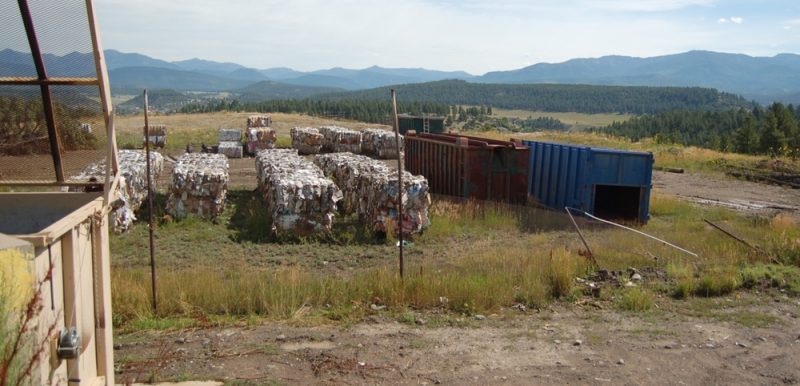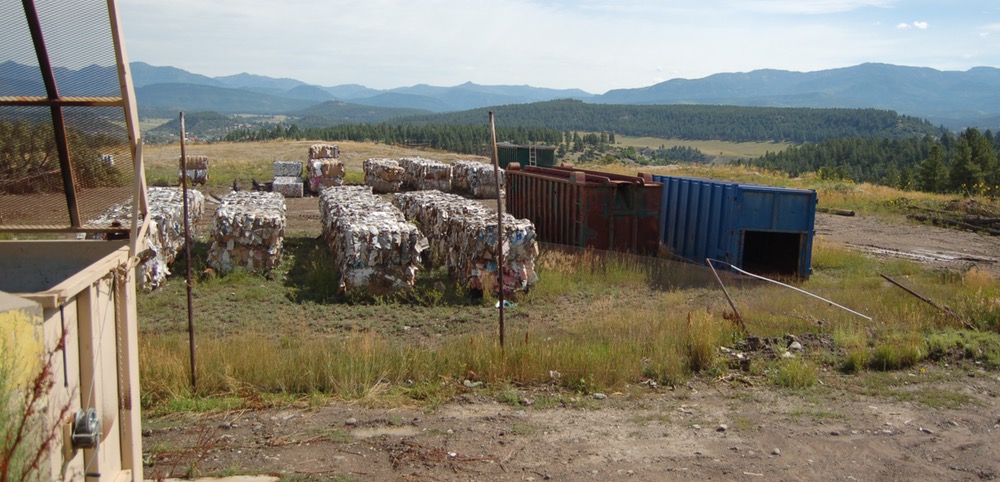
The weekly Pagosa Springs SUN ran an entertaining snippet last Thursday, in the “25 Years Ago” section of their editorial page… taken from SUN files of August 4, 1994:
Gene Crabtree is determined to make recycling work in Archuleta County, and he has invited all residents interested in recycling and those with skills and services to be donated to the cause to attend a meeting tonight at 7pm in the county commissioners meeting room.
Crabtree got involved with the recycling movement early in its development. A school administrator in New Mexico, Crabtree was hired in 1976 by the state of New Mexico to motivate people and communities to start recycling programs.
The new recycling effort spearheaded by [Clifford] Lucero and his company began last spring — with collection bins for paper, glass, and aluminum cans located at the L&M offices on Trujillo road.
Crabtree and Lucero are ready to boost the program. The hope is that tonight’s meeting will produce people willing to accelerate the recycling process in Archuleta County.
Some of our readers may remember local activist Gene Crabtree, who ranched in Pagosa Springs from 1991 until his death in 2009, was active in community organizations and served a term as County Commissioner. At one point in time, the recycling center at the County transfer station on Trujillo Road was referred to as the Gene Crabtree Recycling Center.
It’s a lovely, scenic spot south of downtown Pagosa, overlooking the San Juan Mountains and adjacent to a large meadow that was a previous landfill site, many years ago.
Bales of plastic, cardboard, paper and aluminum decorate the meadow.

Mr. Crabtree embraced the vision some people had been promoting since the 1970s — to mitigate certain negative effects of our consumerist American society, by encouraging and facilitating recycling. Not that this was entirely a new idea. Back in the late 1940s, Americans were recycling around 95% of all milk, soda and beer bottles by returning them directly to grocery stores and liquor stores, or by leaving the washed, empty milk bottles on the doorstep.
Then, in the 1950s, bottles labeled “No Deposit No Return” began to appear on the scene. Around that same time, we started to see “Please Don’t Litter” signs appearing on streets and highways. Mass-produced milk appeared in grocery stores in cardboard cartons. A new aluminum industry developed during World War II found an attractive market, starting in about 1963, for easy-to-chill beverage cans.
At the manufacturing end of the recycle chain, certain types of trash — aluminum, steel, some plastics, some types of paper and cardboard — lend themselves to being used in the manufacture of new products. (Especially when China was willing to accept bales of material, and handle the processing. But China pretty much stopped accepting American trash in 2017.)
During a conversation yesterday with two Archuleta County employees deeply involved in the local solid waste business — Public Works Director Bob Perry and Solid Waste Director Matt Archuleta — we discussed the various types of trash now being recycled. Archuleta County works with Loveland-based Sage Recycling & Waste Solutions to find buyers for their cardboard, paper, and plastic, and to arrange transportation of those materials to various mills.
According to a letter Mr. Archuleta shared, cardboard is now selling for $25 a ton — “the lowest price it has been in 25 years… Prices for OCC [cardboard] today are so low that in many cases the material is not even covering the ever-rising cost of freight to the mill.”
“Mixed paper was hard to move in June… Mexico has pulled back for now…” Prices paid for some plastics are dropping again.
“Prices for Aluminum cans are severely depressed compared to last year’s market…”
Glass recycling, poses special challenges. It’s heavy, and expensive to transport. It breaks easily. It comes in various colors that cannot be mixed together if you want to melt it down to make new glass. Ever since I started recycling my glass here in Archuleta County — when the County transfer station began accepting glass in 2013 — customers have been allowed to throw every color of glass into the same dumpster. At that time, the County believed it could use the glass, crushed, as a lining material for the new landfill cell they were constructing. That didn’t prove to be the case, (the County ended up using normal gravel in the lining) so the County ended up with tons of mixed-color glass that was essentially useless for normal recycling. And too heavy and too expensive to transport. So the glass went into the landfill.
This would be the County landfill on Trujillo Road, which reportedly has a lifespan of maybe 15 more years, if we’re careful.
Is there another cost-effective solution to the glass problem? Grind it up into aggregate? Surely we could find someone who would want 120 tons of ground-up glass annually, for some purpose…
Mr. Archuleta and Mr. Perry shared some of the ideas behind a proposal to have the Town and County governments cooperate financially on the purchase of a glass-crushing machine. Typically, when glass breaks, the shards have sharp, dangerous edges and points, but a machine like the Andela GP-05L (mentioned yesterday in Part One) reportedly produces glass aggregate that is safe to handle, to walk on, and to drive on.

Mr. Perry admitted that the glass aggregate would never ‘replace’ the ordinary rock aggregate used for County road maintenance, but he suggested that some proportion of glass could be mixed into the road gravel without effecting the effectiveness of the gravel application. In other words: instead of dumping all of Pagosa’s glass into our landfill, we could spread it out over 300 miles of gravel roads.
It could also be used in French drains, he suggested, and in other similar applications.
But machinery has a lifespan, just as landfills have a lifespan. If the County was collecting about 10 tons of glass per month, back when glass recycling was still allowed… and if a glass aggregate machine like the Andela GP-05L has a lifespan of 10 years… then, based only on the $110,000 price tag of the machine and not on any labor costs, one ton of ‘glass aggregate’ will cost the taxpayers about $100.
The County buys rock aggregate for about $11 a ton.

